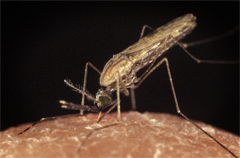
Malaria is a devastating disease that affects nearly 10% of the global population. It causes 1-3 million deaths per year - a death from malaria every 30 seconds. Malaria is an infectious disease caused by the protozoan parasite Plasmodium, and is transmitted in humans by Anopheles mosquitoes. It has been successfully eradicated in Europe and North America in the first half of the twentieth century by effective measures, such as changes in land use, agricultural practices and house construction, and some vector control. The development of the highly effective insecticide DDT heralded a global eradication programme in the 1950s and 1960s. Although successful in the beginning, the programme did not achieve its goals and, as of today, malaria is still a major threat in the third world, especially in Sub-Saharan Africa, where at least 90% of deaths from malaria occur. Even though treatments for malaria exist, drug resistance of Plasmodium, as well as insecticide resistance of the mosquito are major problems in the battle against malaria.
The first insecticide-resistant mosquito strain was discovered in West Africa. Researchers found that its resistance could be associated with a single mutant Anopheles gene, which they named "knock-down resistance" (or kdr) gene. In this e-learning module you will learn how the genetic mechanisms that are responsible for the distribution of the mutated kdr gene within a mosquito population affect evolution in general.
The e-learning module is divided into three parts:- In Part 1 you will learn what mutations and alleles are, how they can affect a cell, an entire organism, or even the following generations, before introducing the resistance allele of the kdr gene from Anopheles
- In Part 2 you will use interactive computer simulations to study how the new kdr allele and alleles in general persist in a population, and how they can even be become prevalent or completely disappear over time.
- In Part 3 you will see how applying insecticides can act as a selective pressure and lead to the rapid emergence of insecticide-resistant mosquitoes.
